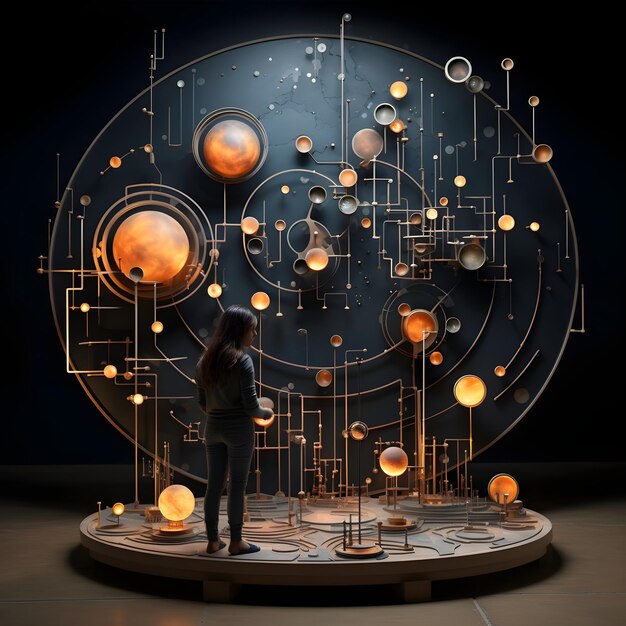Quick Read
String Theory: Does It Actually Describe Our World? New Insights
String theory, a theoretical framework in physics, proposes that the fundamental entities of the universe are not point-like particles, but rather one-dimensional “strings” that vibrate at different frequencies. This theory, first introduced in the late 1960s and early 1970s by physicists like Leonard Susskind and John Schwarz, aims to reconcile quantum mechanics and general relativity, two major pillars of modern physics. However, the question remains: Does string theory actually describe our world? Let’s delve deeper into recent discoveries and insights.
Key Features of String Theory
String theory has several intriguing features. One of its most significant aspects is the multidimensional universe. According to this theory, our world may have more than the three familiar dimensions of length, width, and depth. In fact, some versions of string theory suggest as many as 10 or even 26 dimensions! Another striking feature is the unification of fundamental forces. String theory proposes that all fundamental forces in nature – electromagnetic, weak, strong, and gravitational – can be described as vibrations of the strings.
New Developments in String Theory Research
Recent advancements in string theory research have shed new light on its potential to describe our world. For instance, the AdS/CFT correspondence, a duality between a five-dimensional Anti-de Sitter space and a four-dimensional conformal field theory, has been instrumental in making string theory more concrete and testable. Another promising development is the landscape of vacua, which suggests that our universe might be just one among a vast number of possible vacuum solutions in string theory.
Implications and Challenges
Although string theory has gained significant ground in recent years, it still faces several challenges. One of the most pressing issues is the lack of empirical evidence. While string theory has impressive mathematical coherence, it hasn’t been experimentally confirmed yet. Another challenge lies in the complexity of calculations. The calculations required to make string theory testable are extremely complex, requiring significant computational power and sophisticated mathematical techniques.
Conclusion: String Theory’s Future Prospects
In conclusion, string theory represents an exciting and promising avenue for understanding the fundamental nature of our universe. Its potential to reconcile quantum mechanics and general relativity and unify all fundamental forces is a compelling argument for its relevance. New discoveries, such as the AdS/CFT correspondence and the landscape of vacua, have provided fresh insights into this intriguing theory. However, the challenges that lie ahead, such as the lack of empirical evidence and complex calculations, must be addressed to fully realize string theory’s potential in describing our world.

Paragraph about String Theory in Physics
String Theory, a theoretical framework in modern physics, proposes that the universe is composed of tiny, one-dimensional “strings” rather than point-like particles.
History and Background
This concept emerged in the late 1960s when physicists began to explore the limits of Quantum Field Theory (QFT) and General Relativity. String Theory aimed to reconcile these two seemingly incompatible theories.
Fundamental Concept: Vibrating Strings
According to this theory, these strings vibrate at different frequencies, thus creating various fundamental particles and their corresponding force-carrying particles. A string vibrating at the lowest frequency produces a graviton, for instance, while those vibrating at higher frequencies produce gauge bosons and fermions.
Importance and Significance
The significance of String Theory lies in its potential to unify all fundamental forces of nature, including gravity. It also promises to address the shortcomings of current theories: QFT, which is successful in describing three out of the four fundamental forces (electromagnetic, weak, and strong), fails when it comes to unifying them with gravity.
Objective: Accuracy and New Insights
Our objective is twofold: to evaluate whether String Theory accurately describes our world, and to explore new insights it may offer. Although this theory remains a topic of ongoing research due to its mathematical complexity, the potential for understanding the fundamental nature of our universe makes it an intriguing area of exploration.

Understanding String Theory:
String Theory is a theoretical framework in modern physics that attempts to reconcile quantum mechanics and general relativity by describing the universe as a multidimensional fabric made up of infinitesimally small vibrating strings. Let’s explore some of its key components.
Extra dimensions:
Extra dimensions, beyond the familiar three dimensions of space and one dimension of time, are proposed in String Theory to explain certain inconsistencies between quantum mechanics and general relativity. These extra dimensions are believed to be compactified or “curled up” so tightly that they’re not observable at our scale.
Space-time structure:
Instead of considering the universe as a three-dimensional space with one temporal dimension, String Theory posits that there could be up to 10 or more dimensions, some of which are compactified.
Compactification and dimensionality:
Compactification is the process of “rolling up” the extra dimensions into extremely small sizes, allowing our universe to effectively have only three spatial and one temporal dimension. This concept remains an active area of research in theoretical physics.
Vibrating strings: fundamental particles:
Strings, as the name suggests, are postulated to be the most fundamental constituents of the universe. In this theory:
String vibration modes and particle types:
Vibrating strings produce different particles depending on their specific vibrational modes. Each vibration mode corresponds to a unique particle type, which can include both matter and force-carrying particles.
Unification of matter and energy:
One of the most appealing aspects of String Theory is its potential to unify matter and energy. According to this theory, all fundamental particles are different vibrational modes or manifestations of one universal, unified entity: the string.
Forces in String Theory:
String Theory not only offers a framework for describing fundamental matter but also provides an explanation for the fundamental forces:
Gravity:
Gravity, traditionally viewed as a force between masses, is now considered to be an emergent property of the geometry of the multidimensional space in which strings propagate.
Electromagnetic, weak, and strong forces:
Electromagnetic, weak, and strong nuclear forces
are all viewed as different manifestations of the same underlying quantum field – the gauge fields associated with string vibrations. This leads to a unified description of all fundamental forces in the universe.

I Challenges and Criticisms of String Theory
Despite the promising potential of String Theory in unifying all fundamental forces and particles in the universe, it faces several significant challenges and criticisms. One of the most notable issues is its complex mathematical nature, which presents two major concerns:
Complex Mathematical Nature:
- Difficulty in solving the equations: String Theory involves solving complicated mathematical equations, which have proven to be challenging for scientists. The equations are intricate, and finding exact solutions has been elusive, making it difficult to test the theory experimentally.
- Lack of experimental evidence: The complex mathematical nature of String Theory also makes it hard to produce empirical evidence in support of the theory. Although some experiments have shown promising results, they have not been conclusive enough to validate String Theory beyond a reasonable doubt.
Multiple solutions and vacua:
B.Landscape problem: countless possible universes
Another challenge that arises from String Theory is the multiplicity of solutions and vacua. This issue can be broken down into two parts:
B.1.Landscape problem:
The landscape problem suggests that there could be countless possible universes, each with unique vacuum solutions. This multiplicity poses a significant challenge as it makes it difficult to determine which universe is ours and how we can select it.
B.Selection criterion for our universe
Selecting a particular universe from this vast landscape requires a reliable selection criterion. However, there is currently no consensus on how to choose our universe among the countless possibilities. This uncertainty adds to the controversy surrounding String Theory.
Cosmological constant problem and dark energy
Lastly, String Theory has yet to address the cosmological constant problem and the mystery of dark energy. The cosmological constant is a term that appears in Einstein’s equations of general relativity, which represents the vacuum energy density of the universe. However, its value seems to be inconsistent with observations.
C.Cosmological constant problem:
In String Theory, the cosmological constant arises from vacuum solutions and can be calculated using various methods. However, the calculated value is many orders of magnitude larger than the observed value, which is a significant challenge.
C.Dark energy
The enigma of dark energy, which is believed to make up about 68% of the universe’s total energy content, adds another layer of complexity. String Theory has proposed various solutions for dark energy, but none have been definitively proven yet.
In conclusion, String Theory’s potential to unify all fundamental forces and particles in the universe is compelling. However, its complex mathematical nature and several unsolved challenges, such as the difficulty in finding exact solutions, lack of experimental evidence, multiple vacua, cosmological constant problem, and dark energy, have kept it from gaining universal acceptance.

Role of Artificial Intelligence (AI) in String Theory
artificial intelligence (ai) is revolutionizing various scientific fields, and String Theory is no exception. The intricate nature of String Theory calculations and the vast amount of data require advanced computational tools to unlock new insights.
Machine learning for data analysis and pattern recognition
Machine learning, a subset of AI, has become indispensable in scientific research due to its excellent ability to learn and identify patterns from data. In the context of String Theory, machine learning algorithms are applied to massive datasets for more accurate calculations and analysis.
Applying to String Theory calculations
Machine learning algorithms can process and analyze large quantities of data, enabling more precise calculations in String Theory. They can learn from previous data to make predictions, identify errors, or suggest new solutions.
Identifying new solutions and insights
Machine learning’s pattern recognition capabilities help researchers identify new trends, correlations, or even previously unknown solutions in String Theory. These insights can lead to a better understanding of the underlying physical principles and open up new areas for exploration.
Deep learning and neural networks for theoretical modeling
Deep learning, a subset of machine learning that utilizes artificial neural networks, has shown remarkable success in solving complex problems in various scientific domains. In String Theory, deep learning models can assist researchers in exploring novel possibilities and theoretical frameworks by:
Assisting in solving complex equations
Deep learning models can provide an alternative solution to conventional methods for solving complex equations, making the process more efficient and accurate. They can learn the underlying relationships between various parameters and functions, enabling a deeper understanding of the problem.
Exploring novel possibilities in String Theory
Deep learning models can generate new theoretical frameworks and models within the context of String Theory by identifying patterns, correlations, or relationships that were previously unknown. These novel possibilities may lead to a better understanding of the underlying physical principles and suggest new testable predictions.
Potential advantages of AI in addressing the challenges
AI, with its ability to process vast amounts of data and learn from it, offers several potential advantages when applied to String Theory:
Simplifying mathematical solutions
AI can help simplify complex mathematical problems by providing more efficient algorithms or alternative approaches for solving them, making the process faster and less error-prone.
Enhancing our understanding of physical principles
By identifying patterns, correlations, and relationships that were previously unknown, AI can help researchers gain a deeper understanding of the underlying physical principles in String Theory. This enhanced understanding may lead to new discoveries and insights.
Suggesting new testable predictions
AI’s ability to learn from data and identify patterns can lead to the generation of novel, testable predictions within String Theory. These predictions may challenge existing theories or provide new insights into the underlying physical principles, ultimately contributing to a better understanding of the universe.

Recent Advancements and New Insights from AI in String Theory
Application of machine learning to identify new string solutions
Machine learning, a subfield of artificial intelligence (AI), has been applied to the realm of string theory with remarkable results. Enhanced discovery potential is one of the primary benefits of this application. Machine learning algorithms can process vast amounts of data and identify patterns that may be difficult or impossible for human analysts to detect. For instance, machine learning has been used to analyze large datasets of string solutions, leading to the discovery of new solutions that were previously unknown. Moreover, improved accuracy and efficiency are other significant advantages. Machine learning algorithms can analyze data more accurately and efficiently than humans, making them an invaluable tool for string theorists.
Deep learning for modeling the dynamics of strings in higher dimensions
Another area where AI has made significant strides in string theory is through deep learning. Deep learning, a subset of machine learning, has been used to model the dynamics of strings in higher dimensions. This has led to new insights into particle physics. By analyzing large datasets of string configurations, deep learning algorithms have been able to identify new aspects of particle interactions and behaviors that were previously unobserved. Moreover, deep learning has also provided insights into the landscape problem and vacua selection. The landscape problem in string theory refers to the vast number of possible solutions, or “vacua,” which can lead to different universes with different physical properties. Deep learning algorithms have been able to analyze these vacua and help select the most promising ones for further investigation.
Exploring quantum gravity and string theory through AI
Finally, AI has been used to explore the deeper mysteries of quantum gravity and string theory. Quantum gravity is the field that seeks to reconcile quantum mechanics, which governs the behavior of subatomic particles, with general relativity, which describes the large-scale structure of the universe. String theory is a theoretical framework that attempts to unify quantum mechanics and general relativity by describing all particles as one-dimensional “strings” vibrating at different frequencies. AI has been used to develop new models of quantum gravity, providing a deeper understanding of the relationship between strings, space-time, and fundamental forces. Moreover, AI has also helped provide a deeper understanding of the relationship between strings, space-time, and fundamental forces. By analyzing vast amounts of data, AI algorithms have been able to identify patterns and relationships that were previously unclear, leading to new insights into the nature of reality itself.

VI. Conclusion
String Theory, a theoretical framework aiming to reconcile quantum mechanics and general relativity, has been a subject of intense research for several decades. This multidisciplinary theory proposes that the fundamental building blocks of the universe are one-dimensional strings, rather than point-like particles. String Theory’s primary goals include providing a unified description of all fundamental forces and particles, offering a consistent quantum mechanical description of gravity, and addressing some unresolved issues in physics such as the dark matter and dark energy puzzles. However, String Theory still faces significant challenges, including the absence of experimental evidence, complexity in calculations due to vast numbers of dimensions and strings’ vibrational modes, and the need for a consistent vacuum solution.
Role and Impact of AI in String Theory
Recent advancements in artificial intelligence (AI) have shown significant promise in addressing some of these challenges. AI techniques such as machine learning and deep learning algorithms have been employed to analyze vast amounts of data, making complex calculations more feasible. For instance, machine learning models can be used to identify patterns in strings’ vibrational modes and help researchers understand the underlying physics behind them. Moreover, AI-assisted simulations have proven useful for examining different string configurations, providing insights into various vacuum solutions that might be relevant to the real world.
Future Directions: Potential for Groundbreaking Discoveries and Experimental Validation
Looking ahead, the potential implications of String Theory are vast. Future research directions include further exploring the mathematical frameworks and refining calculations using advanced AI techniques. The potential discovery of a consistent vacuum solution would represent a major breakthrough in our understanding of fundamental physics, potentially leading to new insights into the nature of space-time and the underlying structure of the universe.
Experimental Validation
However, the experimental validation of String Theory remains a critical challenge. Efforts to search for signatures of strings in high-energy particle collisions through experiments at the Large Hadron Collider (LHC) have so far been unsuccessful. Therefore, it is essential to continue exploring alternative avenues for experimental confirmation, such as cosmological observations, astrophysics, and string phenomenology.
Implications for Fundamental Physics and Our Knowledge of the Universe
Should String Theory be proven correct, it would have profound implications for our understanding of the universe. It might help explain long-standing puzzles, such as the origin and properties of dark matter and dark energy. Furthermore, it could lead to a more profound understanding of space, time, and matter, potentially paving the way for new discoveries in various fields of physics.
